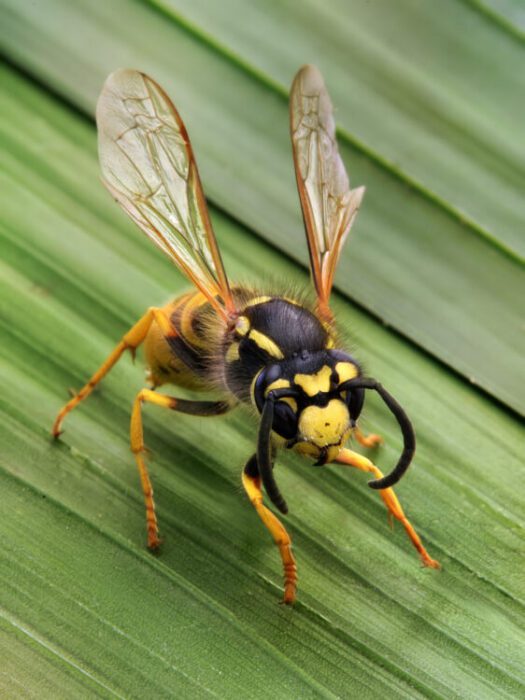Wasps can make simple summer activities like gardening or grilling extremely unpleasant with aggressive stinging attacks. These familiar flying pests create those paper umbrella nests we discover clinging beneath eaves or fence railings each year. But beyond the menace of their stingers, have you ever looked more closely to count a wasp’s total number of legs? Understanding key external anatomical features helps identify wasps correctly and appreciate the adaptations allowing them to inhabit diverse environments.
Table of Contents
In this article, discover:
- The Benefits of 6 Legs for All Flying Insects
- The Different Functions of Each Wasp Leg
- What Happens if a Wasp Loses Any Legs
- Tips for Capturing and Counting Wasp Legs Safely
- What You Can Do If You Find an Odd 5 or 7-Legged Wasp
Learning more about why wasps developed the ability to walk and fly with six legs opens doors to fascination with even perceived nuisance species sharing our living spaces. Read on!
Why Do Wasps and All Insects Have Just 6 Legs?
Wasps belong to the expansive group of animals called Hexapoda, defined by possessing six legs. Over one million species of Hexapods exist globally, encompassing insects like beetles, ants, flies alongside other arthropods such as springtails and diplurans.
This six-legged anatomy grants various evolutionary advantages:
- Swift mobility adapting to diverse habitats from rainforest treetops to desert floors
- Climbing ability allowing vertical ascension on plants, rocky cliffs, and human structures
- Flexibility to launch instantaneous flight when necessary to access resources or escape threats quickly
- Capacity to carry heavier loads of nectar, pollen and other foraging back to nest locations
- Durability to withstand shearing physical forces across varying terrain and weather extremes
For highly social stinging insects like wasps requiring significant daily foraging across wide zones to provision their large colonies of up to 15,000 members, six versatile legs proved pivotal in their success story!
The Different Functions of Each Wasp Leg Pair
Closer inspection reveals wasps move using three sets of specialized legs in sync:
Front Legs – The forward legs contain sensory receptors similar to antennas that detect chemical cues guiding wasps toward nectar, meat and other food sources, nestmates, and preferred nesting sites.
Middle Legs – The middle pair of legs generates the most power, leverage, and efficiency of movement across surfaces. This includes grappling up vertical inclines like tree bark or the sides of structures.
Rear Legs – The rear wasp legs serve essential functions like scrubbing and cleansing their antennae. Their pollen baskets also collect and transport large pollen, nectar and water loads back to feed larvae and colony members.
Damage or Loss of Legs in Wasps
While wasps have one backup set of legs to compensate if injuries occur, losing several legs impairs their critical daily survival tasks:
- Broken or torn legs often result from battles with prey like caterpillars as well as fights with spider guardians protecting egg caches and other nutritious resources.
- Leg loss also occurs when wasp nests suffer large raids by predators who crush or consume developing pupae and larvae. Wasps quickly flee but may escape damaged.
- Severed legs cannot regenerate fully in adult wasps, severely impacting flight stability, foraging load capacity, and defensive ability to inject repeated stings.
So while they survive the loss of 1-2 legs, wasps suffer significantly diminished coordination, mobility and overall functioning that is likely to reduce lifespan without all six intact appendages.
Tips on Safely Capturing and Examining Wasp Legs
Checking out wasp attributes requires care when handling:
- Guide the wasp gently into a clear jar using stiff cardboard underneath for stability. Avoid squeezing their narrow waists tightly.
- Move the jarred wasp to a well-lit indoor setting for closer inspection through the transparent walls. Magnify as necessary for smaller species.
- Systematically count while identifying unique leg adaptations per species using anatomical guides.
- Never pull on wasp legs or wings! This causes severe harm. Gently release uninjured specimens back outside afterward.
What If You Find a 5 or 7-Legged Wasp?
Make notes! While developmental errors rarely allow wasps to fly effectively for survival minus full leg sets, anomalous discoveries intrigue researchers studying evolutionary pathways. Snap photos and contact local insect museums which may collect genetic samples from rare mutants helping advance entomology. Who knows what secrets may emerge from documenting your unusual sighting!
In Conclusion
Wasps truly display fine-tuned anatomy equipping survival in diverse habitats through combined legs specialized distinctly for sensory perception, strength, speed, balance and resource transport. While we may curse these occasionally aggressive insects when guarding sweet picnics and buzzing by too closely, taking time to appreciate elegant physiological details that enable their success unveils profound admiration even for perceived pests sharing our living space!

With over 5+ years of experience in pest control and a PhD in Entomology, our author brings a blend of scientific knowledge and practical expertise to Pestifier.com. Passionate about creating pest-free environments, they provide effective tips and strategies for managing and preventing pest infestations. Connect on Facebook for the latest updates and insights.

